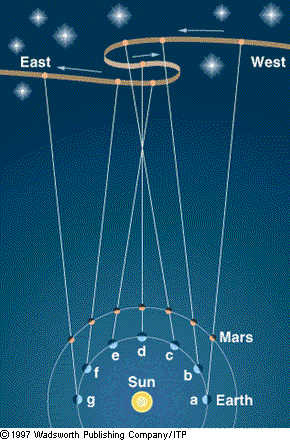
Ancient societies were obsessed with the idea that God must have placed humans at the center of the cosmos (a way of referring to the universe). An astronomer named Eudoxus created the first model of a geocentric universe around 380 B.C. Eudoxus designed his model of the universe as a series of cosmic spheres containing the stars, the sun, and the moon all built around the Earth at its center. Unfortunately, as the Greeks continued to explore the motion of the sun, the moon, and the other planets, it became increasingly apparent that their geocentric models could not accurately nor easily predict the motion of the other planets.

|
Take the apparent motion of Mars from an observer on the Earth, for example. As the Earth and Mars orbit around the sun, Mars appears to advance forwards, and then stop and start moving backwards, and then stop and change direction once again to start moving forwards (shown in the picture at left). You can see in the picture that this phenomenon is easily explained by a heliocentric universe ("heliocentric" meaning the sun is the center of the universe), but imagine being an ancient Greek and trying to understand why Mars would follow such an unusual orbit (when, according to them, it was supposed to have a circular orbit) if the Earth was the center of the universe! |
Until the 1920s, cosmology was still dominated by the theory of a Steady State Universe, or the idea that the universe was homogeneous (has the same general make-up throughout), infinite (that the universe just extends forever), and static (the universe is not expanding, it just is). If you just study the night sky, it seems easy just to think that this is the way the universe has always looked and will always look. In the 20th century, however, observations of the universe did not seem to add up with Steady State theory…
Examples of a heliocentric universe
Return to top.
| Home | Introduction | Brief History | Olbers' Paradox | Hubble Expansion | Big Bang Theory | Electromagnetic Spectrum | CMB | Glossary of Terms |